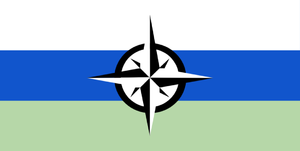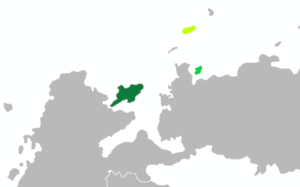Suderavia
This page is currently undergoing major reconstruction in accordance with broader lore changes. |
| Suderavian People's Republic Suderaviax Plānokéarita | |
 Flag | |

| |
| Suderavia in dark green, other Kiravian territories in medium green, disputed Kiravian territories in lime. | |
| Country | |
| Theme | |
| Capital | Xromîda |
| Largest City | Keremonta |
| Population | 2,284,000 |
| Chief Executive | Karolyn Istraxan (UP) |
| Prime Secretary | S.V. Erid (SPP) |
| Legislature | People's Soviet |
| Stanora seats | 3 |
| Official languages | Suderavian Coscivian |
| Recognised languages | Gaelic Kiravic Coscivian Skithanawite Covine |
| Postal Abbreviation | SUD |
| Time Zone | West Levantine Time |
Suderavia, officially the Suderavian People's Republic (Suderaviax Plānokéarita) is an overseas state of the Kiravian Federacy occupying a peninsula in northwestern Levantia.
Georgraphy
Geographically, Suderavia is very mountainous and has a vast system of rivers, valleys, lakes, and mountains that span the region. Though the region is now ideal for many interested in winter sports, buying a cottage/vacation home, the mining business, and ecotourism, it was historically viewed as largely inhospitable land that limited colonial expansion.
— Diamavius Cronscovinus, Suderavia: Lore Once Forgotten
 |
 |
 |
 |
 |
 |
 |
 |
 |
History
The earliest human culture to leave a significant archæological mark on Suderavia was an outlying branch of the Packer Culture, known among scholars as the 'Green Bay Packers' as the densest concentration of Packer artifacts in Suderavia is found around the Keremonta (Ænglish: "Green Bay"). Subsequent inhabitants of what is now Suderavia included pre-Japhetic Levantine peoples such as the Lzveizish and Skithanawites, and the Impaxi.
Coscivian settlements on Suderavia were founded early in the history of Coscivians in Ixnay, around the same time as in Koskenkorva.
Sunderance
[Suderavian Missile Crisis]
Post-Reunification
Politics & Government

Suderavia is a semi-presidential republic. Executive power is exercised by the Governance Commission (Āritakirstuv), or “Cabinet”. Members of the Governance Commission are appointed by the Chief Executive, except for the Prime Commissioner ("the Commish"), who is elected by the People’s Soviet. The People’s Soviet may dismiss the Commission or any of its individual members by a vote of no confidence.
The Chief Executive is elected every five years by instant-runoff vote. The Chief Executive presides over meetings of the Governance Commission and signs its decrees and orders into effect. Independently of the Commission, the Chief Executive is the supreme commander of the Suderavian Defence Force and Suderavian People’s Police, and holds a number of other prerogative powers, such as to make judicial appointments and issue pardons.

The legislative organ is the People’s Soviet, which is elected every two years. Suderavia’s countyships and independent city (Keremonta) serve as its electoral constituencies, and seats are allocated among them with reference to population. Elections to the People’s Soviet are by instant-runoff vote in single-member constituencies and by single transferable vote in multiple-member constituencies. X number of special seats are reserved for the Skithanawite people, who elect their representatives by [general-ticket vote probably]. Skithanawite citizens also vote in the geographic constituencies in which they live.
Political Landscape
Society & Culture
The culture of Suderavia is shaped by its ancient Coscivian heritage and Fhainn contributions, its geographic and environmental conditions, and foreign influences absorbed from neighbouring countries or received from further abroad through the Kilikas Sea trade.
Ethnicity
Coscivian peoples
Celtic Peoples
The Gaelic population of Suderavia are mainly of Fanerian background, with a minority being Kiravian Gaels or Fiannrian Gaels. Suderavia hosts many Gaelic migrant workers from Scapa, a nearby Kiravian protectorate. [Fhainn subgroups]
[Culriochans]
There is reason to believe that the ethnic Covine population of Suderavia is deliberately undercounted by the authorities and could number as high as one fifth of the total population. The General Council of Covine-Kiravians is the leading interlocutor on behalf of this minority group's interests.
Skithanawites
Skithanawites settled in Suderavia in significant numbers during the [CENTURY]. After the Kiravian Civil War, they were joined by a much larger swell of Skithanawite refugees from the Kiravian Mainland, as Skithanawites experienced especially harsh oppression by the Kiravian Union. Skithanawites speak what is believed to be a pre-Japhetic Palæo-Levantine language and have their own customary monarch, who resides in Suderavia during the warmer months and is actively involved in the island's affairs.
Levantine Peoples
Ethnocultural Breakdown of Suderavia
(18.8%)
Language
The Suderavian Coscivian language belongs to the Northern family within the Transkiravian language stock. It is closely related to Kilikas-Valēkas Coscivian, and the two languages are mutually intelligible.
Celtic languages - Gaelic and Fhasen, Covine, and Culriochan - make up the second-largest language bloc.
Kiravic Coscivian is taught in secondary schools and spoken by many transplants from other Kiravian states, as well as in many business settings. It has official recognition from the state, and the state government will accept and process documents filed in Kiravic.
The Skithanaw language is spoken by the Skithanawite community.
The Wyunintran language of neighbouring Unintra is spoken by immigrants and expatriates of Unintran origin, and is widely understood in the isthmus towns. Wyunintran is the most commonly studied foreign language among Suderavian secondary school students (Fhasen is more commonly studied as a second language, but is not considered a foreign language).
Religion
Suderavians are predominantly Christian, though among the Coscivian population many maintain Læstorian, Rurican, and Sarostivist traditions as a “background religion” of sorts. Most Coscivian-Suderavians are either Catholics worshipping according to the Coscivian Rite or belong to the Insular Apostolic Church. The Coscivian Orthodox Church had a significant presence earlier in the peninsula’s history, but by the mid-19th century the last Coscivian Orthodox parishes had either entered communion with Urceopolis or disbanded. It would later be revived during the Sunderance by refugees from other Kiravian states.
The Skithanawites are conclavist Catholic sedevacantists with their own antipope. The Latin Rite Catholic population is made up mainly of Covines and other Levantine residents.
Small numbers of Lutherans, Mercantile Protestants, and Kiravian Sectarian denominations such as the Reformed Orthodox Church and Trinitarian Universalist Church are found in urban areas.
Suderavia is home to a considerable population of Abrigalasts, representing one of the largest and oldest Abrigalast communities in Ixnay. The Abrigalasts of Suderavia arrived fairly early in the history of their faith, having fled persecution in South Levantia and been welcomed by the Covine government of the time to cultivate its more marginal lands. Most Suderavian Abrigalasts do not respond to the Federal Census, but there are estimated to be about 5,000, with around 60% living in Abrigalast settlements, though figures for urban Abrigalasts are likely underreported. Although they are mainly of Levantine ancestry, Suderavian Abrigalasts have spoken Suderavian Coscivian as their native language for centuries.
There are two mosques in Suderavia, one Qustanti and one non-denominational but of Sunni provenance, both in Keremonta. The Bahá’í Local Spiritual Assembly is based in Xromîda and claims 500 adherents, 105 of which are active.
Architecture
Levantine influence on Suderavian architecture is strong and pervasive. Coscivian nationalists on the peninsula looked to Kilikas Brutalism for expression, and since liberation there has been a profusion of Kilikas Brutalist architecture all over the peninsula, especially for public buildings.
 |
 |
 |
 |
Economy


Suderavia's is an economy in transition. Extractive industries - mining, forestry, fisheries, and a small agricultural sector - have always been the mainstay of the Suderavian economy.
Tourism has been an important pillar of the Suderavian economy for quite some time. Since the 1990s, a burgeoning private tourist industry has emerged, catering to enjoyers of winter and outdoor recreation from Levantia and the Kiravian territories. An attendant real estate industry specialising in vacation properties, second homes, and service-oriented development has also taken root, and the accompanying boom in construction jobs has helped smooth over unemployment resulting from the restructuring of industrial and mineral enterprises.